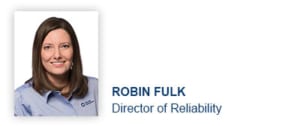Equipment Reliability: How to Ensure Your Success
The Number One Objective
The American Society for Quality (ASQ) defines reliability as:
The probability that a product, system or service will perform its intended function adequately for a specified period of time, or will operate in a defined environment without failure.
Equipment reliability is the number one objective of any predictive maintenance program, but often times programs are started without completing the first, most important step – know the age and performance of the equipment you have.
Don’t Put the Cart Before the Horse
Often preventive maintenance programs are kicked off without having enough asset knowledge to be successful. As they say, “don’t put the cart before the horse.” Before you launch your program, it’s important to:
- Survey | Take inventory of all of mechanical components you own.
- Organize | Make sure that they are cataloged in a Computerized Maintenance Management System (CMMS) or other organized system.
- Rank | Put together a team to rank the criticality of the equipment.
Criticality rankings can be based on a number of different criteria. There is no one right way to do it, but the important thing to keep in mind when assessing criticality is risk – primarily safety, quality, and cost. For example, at POLARIS Laboratories®, we have a preventive maintenance schedule for all of our laboratory instruments, but if our air circulation system experiences downtime then none of those instruments can be operated. It’s a piece of equipment that is often taken for granted, but the risk associated with any downtime is catastrophic and impacts safety and cost.
Once you know what equipment you have and how critical it is to operations, then you can start to assess your fluid analysis program and other predictive tools.
Are you getting the right testing?
If the cost of failure for a specific asset is high, it might be worthwhile to pay for more advanced testing or do analytical ferrography routinely. If the cost is low, you may be able to reduce the sample frequency of some of your equipment. We often talk about preventive maintenance optimization – talk to POLARIS Laboratories® about how we can help you optimize your predictive maintenance intervals.
Proven Impact. Proven Uptime. Proven Savings.
Let us prove it to you.





